Developing service design capability: reflections on studying with the Service Design Academy
This year I have had the fantastic opportunity to study with the Service Design Academy. This intensive course in service design has given me hands-on experience in new techniques.
Service design is an approach that helps organisations see their services from the users’ perspective. In 2015, leading service designer Megan Erin Miller crowdsourced the following definition of service design:
Service design helps organisations see their services from a customer perspective. It is an approach to designing services that balances the needs of the customer with the needs of the business, aiming to create seamless and quality service experiences. Service design is rooted in design thinking, and brings a creative, human-centred process to service improvement and designing new services. Through collaborative methods that engage both customers and service delivery teams, service design helps organisations gain true, end-to-end understanding of their services, enabling holistic and meaningful improvements.
— Megan Erin Miller, Practical Service Design
In essence, service design is very similar in approach to user experience. But while, over time, user experience has become more heavily associated with digital interfaces, service design puts the focus back on the holistic experience — everything involved in running a service that has an impact on our users, including how the organisation and the service works.
PDA in Service Design
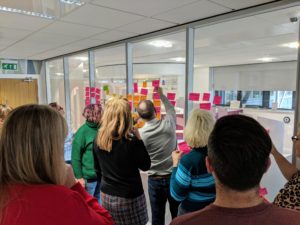
Bootcamp attendees affinity mapping during the tools and methods bootcamp
The course is made up of three units and a workplace-based project. The centrepiece of each of the three units is an intensive two-day bootcamp based in Dundee.
Each of these bootcamps was attended by around 15 people from a variety of organisations — education, local government, NHS, independent businesses — all with an interest in improving their capabilities in service design.
The bootcamps cram a lot in at breakneck pace. Each is centred around a live client brief in a real problem space. The speed and scale of the work often left me feeling wiped out in the evenings. But I was also left in awe of what a small group of people could achieve in a short space of time.
Tools and methods unit
The tools and methods module introduced us to a set of techniques commonly used in service design. Many of these tools — such as personas and empathy maps — were familiar to us.
Personas on the User Experience Service website
But this module also introduced me to several new tools and methods that I could bring back to the team.
As part of my assessment, I used these new methods in a work-based project. I used our work around the future of web services to introduce these methods.
Blog post about our work on the future of web services
Rip and mix
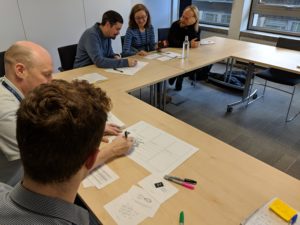
Website and Communications team members working with the rip and mix technique
Rip and mix is a technique that enables lateral thinking to come up with creative ways of improving pain points in a service.
Rip and mix described by Open Change, who created the technique
With rip and mix, you take a good product or service and analyse what makes it pleasurable to use. You then compare this to a pain point in a current service. Elements of the pleasurable service are then mixed with elements of the pain point, to create a hypothetical new service.
This tool helped our team come up with some highly creative ideas. My favourite was an on-demand website MOT, using the pleasurable experience of a car MOT and service to tackle the pain point of demand for CMS features not being met. It was interesting to see common themes among the three groups’ ideas as well — all of them included a physical element.
An easy way to encourage some creative thinking and bring about fresh ideas.
— Bruce Darby, Project Manager
Tomorrow’s news
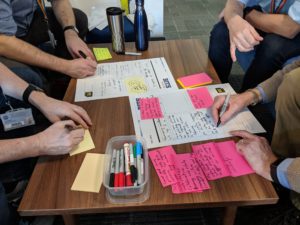
Imagining future front pages of BITS magazine
This activity involves designing a newspaper front page a few years in the future, as a way of imagining what you would like to be reported about the outcomes of your redesigned service, or understanding the impact it might have.
Tomorrow’s news described by Service Design Tools
As the users of our service are mainly internal, I adapted the newspaper template to make it look like a copy of BITS, the Information Services magazine.
This is a simple but powerful activity. I was impressed to see it prompt some interesting discussions among team members about what we want to achieve.
I found this activity really useful as it allowed expressing a high-level vision in a quick and natural way. Furthermore, it helped identifying common (or not) ground and encouraged creative discussions around the agreed theme.
— Stratos Filalithis, Head of Website and Communication Technologies
User research unit
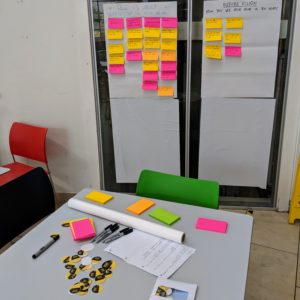
Our research station in the college canteen
I have done a fair amount of user research in my career in higher education. But during this bootcamp we were set a brief that involved researching groups of people who were facing all sorts of challenges in their home lives.
We were sent to a housing association estate to knock on people’s doors and conduct open interviews with users of a housing association on the topic of the future of housing.
Very often, the future of housing was the last thing on these people’s minds. The here and now was more pressing. In itself, that was a powerful finding.
It was a very different experience knocking on the doors of complete strangers, and being faced with some hard-hitting realities — right in people’s living rooms. It got me thinking a lot.
In more familiar territory for me, we also had some fun chatting to college students in the canteen, plying them with sweets and stickers in exchange for a different perspective on our topic.
Co-design unit
The third and final bootcamp was on co-design. Here we were set the exciting challenge of helping Dundee & Angus College foster greater collaboration between its Horticulture, Professional Cookery, Hospitality and Science departments. This desire had emerged from previous user research conducted with the Service Design Academy.
This was a fascinating challenge. We were encouraged to consider the physical space as well as the services on offer and the students’ experience.
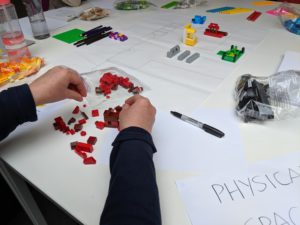
Service users worked with Lego to prototype ideas for the physical space
We worked with students and staff to create a Lego prototype of the new campus. With this, we imagined ways the physical space might be improved to increase collaboration between the different departments, enable students from different courses to learn from each other and attract members of the public to visit the horticulture gardens and the training restaurant.
That last item in itself was an interesting topic. I used to live a 20 minute walk away from the campus for four years, and have driven past it countless times. Yet I had no idea that these gardens were there or that members of the public could visit.
Project
For the project, I had to demonstrate the ability to design, plan and deliver a service design project at work. I used our work on future web services to introduce some new service design concepts through our co-design events with colleagues across the University.
Reflections on the course
Studying for the PDA in Service Design has been very fulfilling. The intensive and fast-paced nature of the bootcamps made them feel overwhelming at times. But it was inspiring to see what could be achieved in such a short space of time, and exciting to work with a variety of fellow learners working in service design.
It was also interesting to see the parallels between service design thinking and the way we have been working on the Learn Foundations project.
Blog posts about Learn Foundations
This way of working isn’t new to us. But studying with the Service Design Academy has given me some new approaches and a fuller understanding of design theory.
Best of all has been the time I’ve spent reading and thinking more about service design. My happy brain is now filled with fresh information and perspectives.
Working on the co-design unit in particular was a source of great inspiration for me. I’m looking forward to applying this new thinking to future projects.


4 replies to “Developing service design capability: reflections on studying with the Service Design Academy”